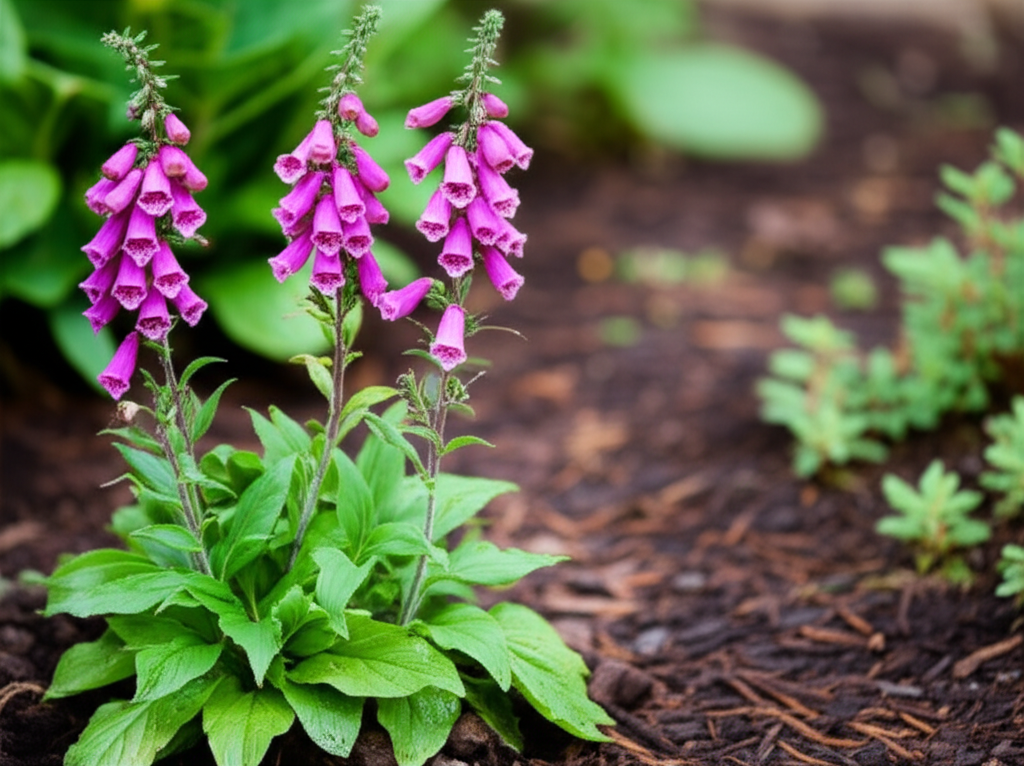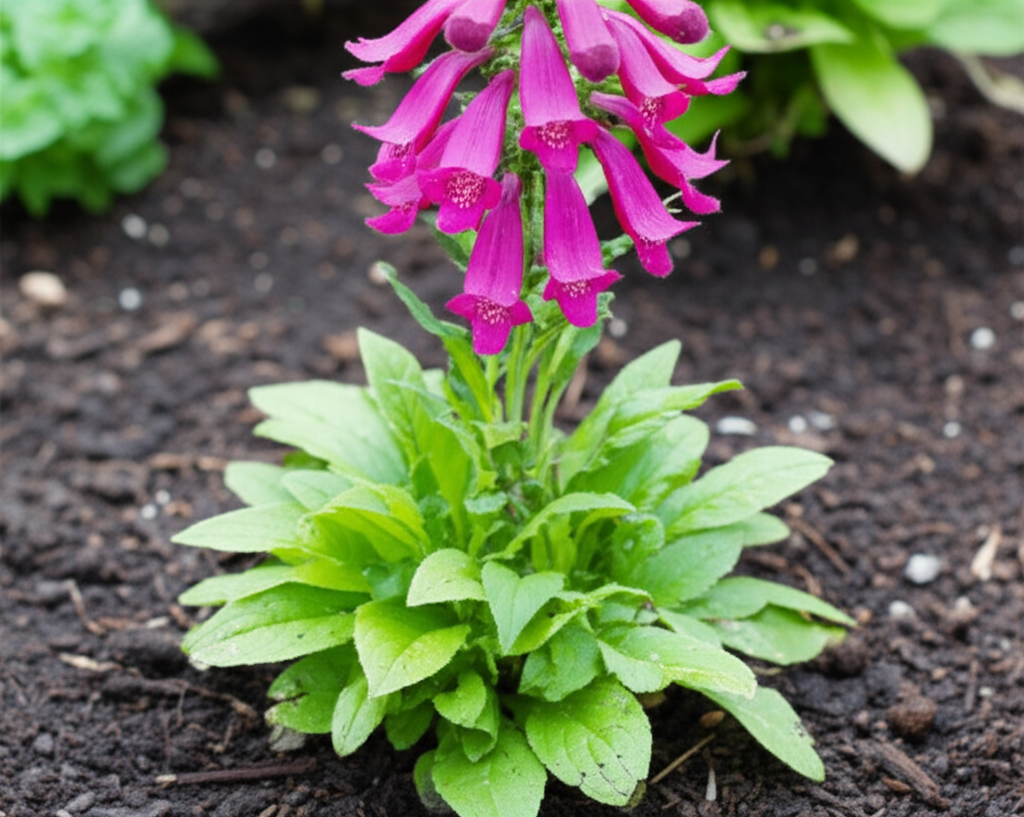The Essence of Foxglove Beardtongue and Its Soil Needs
Foxglove beardtongue, scientifically known as Penstemon digitalis, is a captivating native perennial that brings a touch of wild elegance to any garden. Renowned for its tall spires of delicate, tubular white to pale pink flowers, it’s a magnet for pollinators like bees and butterflies. Beyond its aesthetic appeal, Penstemon digitalis is celebrated for its adaptability and resilience, often thriving in a variety of conditions. However, to truly unlock its full potential for robust growth, prolific blooming, and a healthy lifespan, understanding its specific soil nutrient requirements is paramount.
While foxglove beardtongue is not overly demanding, providing the right balance of soil nutrients can significantly enhance its performance. This guide will delve into the fundamental nutrient needs of this beloved plant, exploring how to assess your existing soil, identify potential deficiencies, and implement effective supplementation strategies. From nitrogen’s role in leafy growth to phosphorus’s contribution to root development and potassium’s impact on overall plant health, we will cover the essential elements and how to best provide them for your Penstemon digitalis.
Understanding Essential Plant Nutrients
Plants, much like humans, require a spectrum of nutrients to grow, thrive, and reproduce. These nutrients are broadly categorized into macronutrients and micronutrients. Macronutrients are required in larger quantities and are the building blocks of plant structure and function. Micronutrients, while needed in smaller amounts, are equally vital for specific physiological processes.
Macronutrients: The Foundation of Growth
The primary macronutrients are:
- Nitrogen (N): Crucial for vegetative growth, promoting lush foliage and vibrant green color. It’s a key component of chlorophyll, essential for photosynthesis.
- Phosphorus (P): Vital for root development, flowering, and seed production. It plays a role in energy transfer within the plant.
- Potassium (K): Important for overall plant health, disease resistance, water regulation, and the strength of stems.
Secondary macronutrients, also needed in significant amounts, include calcium, magnesium, and sulfur.
Micronutrients: The Catalysts of Life
Micronutrients, though required in trace amounts, are indispensable for a plant’s metabolic processes. These include:
- Iron (Fe): Essential for chlorophyll formation and photosynthesis.
- Manganese (Mn): Involved in photosynthesis, respiration, and nutrient uptake.
- Zinc (Zn): Crucial for enzyme activity and hormone production.
- Copper (Cu): Plays a role in enzyme activity and photosynthesis.
- Boron (B): Important for cell wall development, pollination, and fruiting.
- Molybdenum (Mo): Essential for nitrogen metabolism.
- Chlorine (Cl): Involved in osmosis and ionic balance.
Assessing Your Garden Soil for Foxglove Beardtongue

Before embarking on any nutrient supplementation, a thorough assessment of your existing garden soil is the crucial first step. This assessment helps identify what your soil already provides and where potential deficiencies lie, preventing over-fertilization which can be as detrimental as under-fertilization.
Soil Testing: The Scientific Approach
The most accurate way to understand your soil’s nutrient profile is through a professional soil test. Local agricultural extension offices or reputable garden centers often offer this service. A soil test will typically analyze:
- pH Level: This measures the acidity or alkalinity of your soil, which significantly impacts nutrient availability. Foxglove beardtongue generally prefers slightly acidic to neutral soil, with a pH range of 6.0 to 7.0.
- Macronutrient Levels: The test will report the existing levels of nitrogen, phosphorus, and potassium, as well as calcium and magnesium.
- Micronutrient Levels: Some tests will also provide information on essential micronutrients.
- Organic Matter Content: This indicates the amount of decomposed plant and animal material in your soil, a vital source of slow-release nutrients and a key factor in soil structure and water retention.
Observational Clues: Recognizing Soil Deficiencies
While a soil test is definitive, certain visual cues can offer preliminary indications of nutrient imbalances. These are often general plant health indicators and may not specifically point to foxglove beardtongue issues without other context.
Visual Indicators of Nutrient Deficiencies
- Nitrogen Deficiency: Yellowing of older leaves (chlorosis), stunted growth, pale overall plant color.
- Phosphorus Deficiency: Purplish discoloration on leaves and stems, poor root development, delayed flowering.
- Potassium Deficiency: Yellowing or browning along leaf margins, weak stems, reduced disease resistance.
- Iron Deficiency: Yellowing of younger leaves with green veins (interveinal chlorosis).
It is important to remember that these symptoms can also be caused by other factors like inadequate watering, poor drainage, or pest infestations, so a soil test remains the most reliable diagnostic tool.
Nutrient Supplementation Strategies for Foxglove Beardtongue
Once you have a clear understanding of your soil’s composition and the specific needs of your foxglove beardtongue, you can implement targeted supplementation strategies. The goal is to provide a balanced diet that supports healthy vegetative growth, abundant flowering, and overall resilience.
Optimizing Soil pH
The pH level of your soil is critical because it affects how well plants can absorb nutrients from the soil.
- If your soil is too acidic (low pH): Incorporate agricultural lime (calcium carbonate) to raise the pH.
- If your soil is too alkaline (high pH): Add elemental sulfur or organic amendments like peat moss or pine needles to lower the pH.
Always apply amendments gradually and retest your soil after a few months to gauge the effect.
Incorporating Organic Matter: The Natural Approach
Organic matter is the cornerstone of healthy soil and a fantastic, slow-release source of a wide array of nutrients. Regularly amending your soil with compost, well-rotted manure, or leaf mold is highly beneficial for foxglove beardtongue.
- Compost: Provides a balanced mix of essential nutrients, improves soil structure, and enhances water retention.
- Aged Manure: A rich source of nitrogen and other nutrients, but ensure it is well-composted to avoid burning plant roots.
- Leaf Mold: Decomposed leaves are excellent for improving soil structure and adding micronutrients.
Incorporating a 2-3 inch layer of organic matter into the top 6-8 inches of soil annually, especially in the spring, will significantly boost your foxglove beardtongue’s health.
Choosing the Right Fertilizers
When organic amendments alone aren’t sufficient, or for a more targeted approach, fertilizers can be used. It’s important to choose fertilizers appropriate for the plant’s needs and your soil’s specific deficiencies identified by a soil test.
Types of Fertilizers
- Balanced Fertilizers: Fertilizers labeled with three numbers (e.g., 10-10-10) indicate the percentage by weight of nitrogen (N), phosphorus (P), and potassium (K), respectively. A balanced fertilizer can be a good starting point if your soil test indicates no major deficiencies.
- Low-Nitrogen Fertilizers: If your soil test shows high nitrogen but low phosphorus or potassium, a fertilizer with lower nitrogen content (e.g., 5-10-10) would be more appropriate. This encourages flowering over excessive leafy growth.
- Organic Fertilizers: Options like bone meal (phosphorus), blood meal (nitrogen), and kelp meal (potassium and micronutrients) offer natural alternatives.
Application Timing and Methods
The best time to fertilize foxglove beardtongue is typically in early spring as new growth emerges. A light application is usually sufficient. Avoid over-fertilizing, as this can lead to weak, leggy growth that is more susceptible to pests and diseases, and can also reduce flowering.
Key Soil Nutrient Comparison for Foxglove Beardtongue
Here’s a comparative overview of the primary macronutrients and their role for foxglove beardtongue, along with ideal soil ranges where available:
| Nutrient | Role in Foxglove Beardtongue | Ideal Soil pH Range for Availability | Common Deficiency Symptoms | Organic Sources | Synthetic Sources |
|---|---|---|---|---|---|
| Nitrogen (N) | Promotes lush foliage, stem growth, and overall green color. Essential for photosynthesis. | 6.0 – 7.0 | Yellowing of older leaves, stunted growth, pale green foliage. | Compost, aged manure, blood meal, alfalfa meal. | Ammonium nitrate, urea, ammonium sulfate. |
| Phosphorus (P) | Crucial for root development, flowering, and seed formation. Aids in energy transfer. | 6.0 – 7.0 | Poor root systems, delayed flowering, sometimes purplish discoloration of leaves and stems. | Bone meal, rock phosphate, compost. | Superphosphate, triple superphosphate. |
| Potassium (K) | Enhances overall plant health, improves water regulation, strengthens stems, and increases disease resistance. | 6.0 – 7.0 | Yellowing or browning along leaf margins (scorching), weak stems, reduced bloom quality. | Kelp meal, wood ash (use sparingly and with caution regarding pH), compost. | Potassium chloride (muriate of potash), potassium sulfate. |
| Calcium (Ca) | Important for cell wall structure and growth regulation. | 6.0 – 7.0 | Stunted growth, deformed new leaves, blossom end rot (less common in flowering plants, but indicates general deficiency). | Lime (dolomitic lime adds magnesium too), bone meal, gypsum. | Calcium nitrate. |
| Magnesium (Mg) | Essential component of chlorophyll and involved in enzyme activity. | 6.0 – 7.0 | Interveinal chlorosis (yellowing between veins) on older leaves. | Epsom salts (magnesium sulfate), dolomitic lime, compost. | Magnesium sulfate. |
Best Practices for Supplementation and Ongoing Care
Implementing nutrient supplementation is not a one-time event but part of a continuous process of soil management and plant care. Adhering to best practices ensures the longevity and continued health of your foxglove beardtongue.
Step-by-Step Supplementation Process
Follow these steps for effective soil nutrient supplementation for your foxglove beardtongue:
- Conduct a Soil Test: This is the foundational step to understand your soil’s pH and nutrient levels.
- Amend Soil pH: Based on test results, adjust soil pH using appropriate amendments (lime or sulfur).
- Incorporate Organic Matter: Annually, in spring or fall, top-dress with compost, aged manure, or leaf mold. Gently work it into the top few inches of soil.
- Apply Fertilizers (if necessary): If soil tests reveal specific deficiencies not met by organic matter, apply a targeted fertilizer. Follow product instructions carefully.
- Water Thoroughly: After applying any soil amendments or fertilizers, water the area well to help nutrients dissolve and be absorbed by the roots.
- Monitor Plant Health: Regularly observe your foxglove beardtongue for signs of nutrient deficiencies or excesses.
- Retest Soil Periodically: It’s advisable to retest your soil every 2-3 years to ensure nutrient levels remain balanced.
Pros and Cons of Different Supplementation Approaches
Both organic and synthetic methods have their advantages and disadvantages. Understanding these can help you make informed decisions for your garden.
| Approach | Pros | Cons |
|---|---|---|
| Organic Matter (Compost, Manure, etc.) |
|
|
| Synthetic Fertilizers |
|
|
Ongoing Care and Observation
Beyond initial supplementation, consistent monitoring and care are essential for a thriving foxglove beardtongue.
- Watering: While foxglove beardtongue is drought-tolerant once established, consistent moisture, especially during dry spells and flowering, will lead to better bloom production. Ensure good drainage to prevent root rot.
- Mulching: A layer of mulch around the base of the plant helps retain soil moisture, suppress weeds, and regulate soil temperature, all of which contribute to nutrient uptake and overall health.
- Deadheading: Removing spent flower stalks can encourage the plant to produce more blooms and direct energy into root and foliage development rather than seed production.
- Dividing: Mature plants may benefit from division every 3-5 years. This rejuvenates the plant and can be an opportunity to amend the soil where they are replanted.
By understanding and addressing the soil nutrient needs of Penstemon digitalis with a balanced approach of organic matter incorporation and judicious fertilization, you can cultivate a garden spectacle that rewards you with vigorous growth and a profusion of beautiful blooms for years to come.


